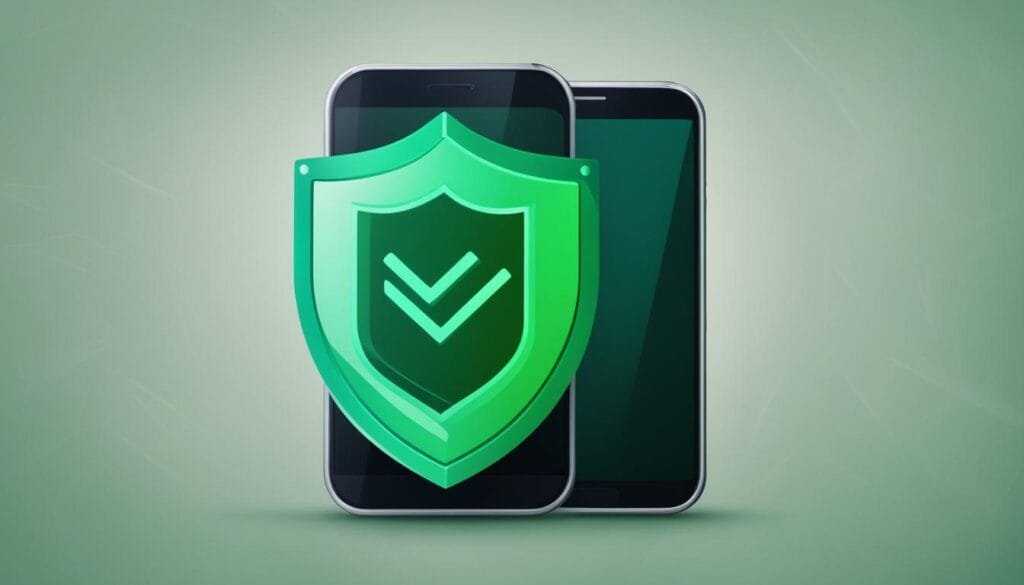Phishing scams have become a pervasive threat in our increasingly digital world. These fraudulent attempts by cybercriminals aim to deceive individuals into revealing sensitive information, putting their personal data and financial security at risk. While phishing scams can occur through various communication channels, including emails, text messages, and voice calls, mobile phishing has emerged as a significant concern.
Mobile phishing, or mobile smishing, targets individuals through their smartphones and other mobile devices. With more people relying on their mobile devices for everyday tasks, it is crucial to be able to spot and avoid mobile phishing attempts. By understanding the tactics used by cybercriminals and implementing effective protective measures, you can safeguard yourself from falling victim to these scams.
Key Takeaways:
- Phishing scams are fraudulent attempts to deceive individuals and extract sensitive information.
- Mobile phishing, or mobile smishing, targets individuals through their smartphones and other mobile devices.
- It is essential to be able to spot and avoid mobile phishing attempts to protect your personal information.
- Stay informed about the tactics used by cybercriminals and implement protective measures such as strong passwords and security software.
- Regularly update your mobile devices and apps to stay ahead of potential vulnerabilities.
Types of Phishing Scams to Look Out For
Phishing scams come in various forms, targeting individuals through different channels of communication. It is essential to be aware of these types of scams to recognize and avoid falling victim to them. The most common types of phishing scams include email phishing, text message phishing (smishing), and voice phishing (vishing).
Email phishing
Email phishing is one of the most prevalent forms of phishing scams. It involves cybercriminals sending deceptive emails that appear to be from legitimate organizations or individuals. These emails often attempt to trick recipients into providing sensitive information, such as login credentials or financial details. The emails may contain links that lead to fake websites designed to steal personal information.
Text message phishing
Text message phishing, also known as smishing, targets individuals through SMS messages. Fraudsters send text messages posing as trusted entities, such as banks or government agencies, and attempt to deceive recipients into sharing personal information or clicking on malicious links. Text message phishing scams often employ urgent or enticing language to manipulate individuals into taking immediate action.
Voice phishing
Voice phishing, also referred to as vishing, involves fraudsters using phone calls to impersonate trusted individuals or organizations. The scammers manipulate recipients into providing sensitive information or performing specific actions by creating a sense of urgency or authority. Voice phishing scams can be particularly convincing, as the fraudsters may use spoofed caller IDs or mimic the voice of someone the recipient knows.
Common Phishing Approaches
Phishing scams can employ various approaches to deceive individuals and gain access to their personal information. Some common techniques include:
- Spoofing legitimate websites or organizations to trick individuals into entering their login credentials or financial details.
- Creating fake landing pages or pop-up windows that prompt individuals to enter their information.
- Using social engineering tactics, such as pretending to be a colleague or acquaintance, to manipulate individuals into sharing sensitive data.
- Sending malicious attachments or links that, when clicked, install malware or lead to compromised websites.
By understanding the types of phishing scams and the common approaches used by cybercriminals, individuals can be better prepared to spot and avoid falling victim to these fraudulent schemes.
How to Protect Yourself from Phishing Attempts
Phishing attempts have become increasingly sophisticated, making it more important than ever to be able to recognize and protect yourself from these scams. By staying vigilant and following a few key practices, you can significantly reduce your risk of falling victim to phishing attacks.
Red Flags of Phishing
One of the first steps in protecting yourself from phishing attempts is to be aware of the red flags. Phishing emails often have generic greetings or urgent and threatening language. They may also contain spelling and grammar errors. If an email seems suspicious or too good to be true, it’s essential to proceed with caution.
Verify Sender’s Information
Phishing emails often masquerade as legitimate organizations or individuals. To protect yourself, always verify the sender’s information before clicking on any links or providing any personal information. Check the email address and any contact information provided for any signs of suspicious or unfamiliar elements.
Multifactor Authentication
Enabling multifactor authentication (MFA) adds an extra layer of security to your accounts. With MFA, even if cybercriminals manage to obtain your password, they won’t be able to access your account without the additional verification step. It’s crucial to enable MFA on all your accounts that offer this feature to enhance your protection against phishing attacks.
Mindful Sharing of Personal Information
When it comes to personal information, always be cautious about sharing it online. Phishing attempts often rely on tricking individuals into providing sensitive information, such as social security numbers, credit card details, or login credentials. Think twice before sharing personal information online unless you are confident in the legitimacy and security of the website or platform.
Comprehensive Security Suite
Investing in a comprehensive security suite can provide an extra layer of protection against phishing attempts. These security suites often include features such as anti-phishing filters, spam detectors, and real-time threat analysis. By utilizing a robust security solution, you can further fortify your defenses against phishing attacks.
By staying informed and implementing these protective measures, you can better shield yourself from the risks of phishing attempts. Always remember to trust your instincts, be cautious when dealing with online communications, and prioritize the security of your personal information.
The Impact of Phishing and the Importance of Education
Phishing attacks have become a prevalent threat in today’s digital landscape, with data breaches involving phishing attempts accounting for a significant number of cybersecurity incidents. The statistics speak for themselves, highlighting the pressing need for robust cybersecurity measures and comprehensive training programs.
According to recent phishing statistics, phishing scams have led to substantial financial losses for individuals and organizations alike. In 2020 alone, it is estimated that phishing attacks cost businesses over $1.7 billion in losses. These attacks not only result in financial harm but also have severe consequences for the victims, including identity theft, unauthorized access to sensitive information, and reputational damage.
To combat the growing threat of phishing, education and awareness are paramount. Cybersecurity training programs play a vital role in equipping individuals with the knowledge and skills necessary to identify and avoid falling victim to these scams. By educating employees and individuals on the red flags of phishing attempts, such as suspicious emails or unauthorized requests for personal information, organizations can significantly reduce their vulnerability to phishing attacks.
“Phishing simulations can also serve as an invaluable tool in reinforcing cybersecurity awareness and training. By simulating realistic phishing scenarios, organizations can test their employees’ ability to recognize and respond to phishing attempts in a safe and controlled environment,” says cybersecurity expert Jane Smith.
It is crucial for individuals and organizations to stay proactive in their efforts to combat phishing scams. Investing in regular cybersecurity training, implementing multifactor authentication, and utilizing comprehensive security suites are essential steps to protect against these attacks. By prioritizing education and taking preventive measures, we can collectively mitigate the impact of phishing and create a safer digital environment for all.
Stay Vigilant and Protect Yourself from Phishing Scams
In today’s digital age, the threat of phishing scams is ever-present. However, with the right knowledge and constant vigilance, you can protect yourself and your sensitive information from falling into the hands of cybercriminals. The following tips will help you stay safe online and prevent phishing attempts.
1. Prioritize Phishing Prevention: Make cybersecurity awareness a top priority. Stay informed about the latest phishing techniques and regularly update your knowledge on how to spot and avoid scams. By staying educated, you can detect red flags and protect yourself proactively.
2. Enhance Your Cybersecurity Awareness: Develop a strong sense of cybersecurity awareness by being mindful of the information you share online. Be cautious when clicking on links or downloading attachments from unknown sources, as they may lead to phishing attempts. Always remember that legitimate organizations will never ask for sensitive information through email or text message.
3. Strengthen Your Online Security: Implement robust security measures to safeguard your digital presence. Utilize strong and unique passwords for your accounts and enable two-factor authentication whenever possible. Keep your devices and software updated with the latest security patches to ensure protection against known vulnerabilities.
4. Prioritize Digital Safety: Stay alert and practice good digital safety habits. Regularly review your financial statements and monitor your accounts for any suspicious activities. Be cautious about sharing personal information on social media platforms and only connect with trusted individuals or organizations. Remember, protecting your personal data is paramount in the fight against phishing scams.
By following these steps, you can significantly reduce the risk of falling victim to phishing scams. Stay vigilant and stay informed to keep yourself safe in the ever-evolving digital landscape. Protecting your personal information is crucial, and with the right precautions, you can navigate the online world confidently and securely.
FAQ
What is a phishing scam?
A phishing scam is a fraudulent attempt by cybercriminals to deceive individuals into revealing sensitive information through text, emails, or other digital communication methods.
What are the different types of phishing scams?
Phishing scams come in various forms, including email phishing, text message phishing (smishing), and voice phishing (vishing).
How can I protect myself from phishing attempts?
To protect yourself from phishing attempts, it is crucial to be able to identify red flags such as generic greetings, urgent or threatening language, spelling, and grammar errors in phishing emails. Verifying the sender’s information, using multifactor authentication, being cautious about sharing personal information online, and using a comprehensive security suite are essential measures to take in safeguarding against phishing attacks.
What impact do phishing scams have?
Phishing attacks have a significant impact, with data breaches involving phishing attacks accounting for many cybersecurity incidents.
How can education help in avoiding phishing scams?
It is crucial to educate individuals on the risks of phishing and provide cybersecurity training to help them recognize and avoid falling victim to these scams. Phishing simulations can also be effective in enhancing employees’ understanding and enabling them to detect and avoid phishing attacks in a safe environment.
How can I stay protected from phishing scams?
By staying informed, staying cautious, and implementing the necessary security measures like using multifactor authentication and comprehensive security suites, you can significantly reduce the risk of becoming a victim of phishing scams.
What Steps Should I Take to Report Mobile Phishing Scams and Fraud?
If you encounter a mobile phishing scam or suspect mobile banking fraud, follow these crucial steps for reporting mobile banking fraud. Contact your banking institution immediately to alert them of the fraudulent activity. Additionally, forward suspicious emails or text messages containing phishing attempts to your bank. Finally, inform your local law enforcement authorities who can assist in taking appropriate action against the scammers.


Pingback: Swap Out the Scammers: Protecting Yourself from SIM Swap Fraud – Straight Fire Money